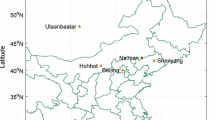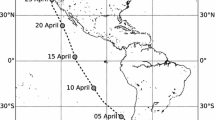Abstract
Aerosol number fluxes are spectrally analyzed using fast Fourier transform analysis, wavelet analysis and multiresolution decomposition. All three methods yield similar spectral features in general, although a detailed evaluation of the cospectra shows some differences, e.g. due to different resolutions in the time and frequency domains. Wavelet analysis yields aerosol flux estimates with a high time resolution that can be used to assess the flux variability. Multiresolution decomposition has been applied successfully to evaluate cospectra of the aerosol number flux, the buoyancy flux and the momentum flux of three 1-day datasets from diverse environments. For all scalars and all environments, the dimensionless frequency (f) of the cospectral peak was found between \(f = 0.1\) and 0.2. In addition, the cospectral gap time scale of the aerosol number flux was found between 100 and 1,000 s. Thus, in this study several spectral features such as the dominant time scale and the cospectral gap time scale of aerosol number fluxes are similar to buoyancy fluxes. However, the shape of aerosol number flux cospectra often deviates from buoyancy and momentum flux cospectra, especially at very small and at very large time scales.







Similar content being viewed by others
References
Collineau S, Brunet Y (1993) Detection of turbulent coherent motions in a forest canopy, part I: wavelet analysis. Boundary-Layer Meteorol 65:357–379
Dupuis H, Taylor PK, Weill A, Katsaros K (1997) Inertial dissipation method applied to derive turbulent fluxes over the ocean during the surface of the ocean, fluxes and interactions with the atmosphere/Atlantic Stratocumulus Transition Experiment (SOFIA/ASTEX) and Structure des Echanges Met-Atmosphere, Proprietes des Heterogeneites Oceaniques: Recherche Experimentale (SEMAPHORE) experiments with low to moderate wind speeds. J Geophys Res 102:21115–21129
Edson JB, Fairall CW, Mestayer PG, Larsen SE (1991) A study of the inertial-dissipation method for computing air–sea fluxes. J Geophys Res 96:10689–10711
Eugster W, Senn W (1995) A cospectral correction model for measurement of turbulent NO2 flux. Boundary-Layer Meteorol 74:321–340
Farge M (1992) Wavelet transforms and their applications to turbulence. Annu Rev Fluid Mech 24:395–457
Foken T (2008) Micrometeorology. Springer, Heidelberg, 308 pp
Grinsted A, Moore JC, Jevrejeva S (2004) Application of the cross wavelet transform and wavelet coherence to geophysical time series. Nonlinear Process Geophys 11:561–566
Held A, Klemm O (2006) Direct measurement of turbulent particle exchange with a twin CPC eddy covariance system. Atmos Environ 40:S92–102
Held A, Nowak A, Wiedensohler A, Klemm O (2006) Field measurements and size-resolved model simulations of turbulent particle transport to a forest canopy. J Aerosol Sci 37:786–798
Held A, Patton E, Rizzo L, Smith J, Turnipseed A, Guenther A (2008) Relaxed eddy accumulation simulations of aerosol number fluxes and potential proxy scalars. Boundary-Layer Meteorol 129:451–468
Held A, Brooks IM, Leck C, Tjernström M (2011) On the potential contribution of open lead particle emissions to the central Arctic aerosol concentration. Atmos Chem Phys 11:3093–3105
Howell JF, Mahrt L (1997) Multiresolution flux decomposition. Boundary-Layer Meteorol 83:117–137
Kaimal JC, Finnigan J (1994) Atmospheric boundary layer flows: their structure and measurement. Oxford University Press, New York, 289 pp
Kaimal JC, Wyngaard JC, Izumi Y, Coté OR (1972) Spectral characteristics of surface-layer turbulence. Q J R Meteorol Soc 98:563–589
Klemm O, Held A, Forkel R, Gasche R, Kanter H-J, Rappenglück B, Steinbrecher R, Müller K, Plewka A, Cojocariu C, Kreuzwieser J, Valverde-Canossa J, Schuster G, Moortgat GK, Graus M, Hansel A (2006) Experiments on forest/atmosphere exchange: climatology and fluxes during two summer campaigns in NE Bavaria. Atmos Environ 40:S3–20
Lenschow DH, Stankow BB (1986) Length scales in the convective boundary layer. J Atmos Sci 43:1198–1209
Lenschow DH, Mann J, Kristensen L (1994) How long is long enough when measuring fluxes and other turbulence statistics. J Atmos Ocean Technol 11:661–673
Mallat SG (1989) A theory for multiresolution signal decomposition: the wavelet representation. IEEE Trans Pattern Anal Mach Intell 7:674–693
Patton EG, Horst TW, Lenschow DH, Sullivan PP, Oncley S, Burns S, Guenther A, Held A, Karl T, Mayor S, Rizzo L, Spuler S, Sun J, Turnipseed A, Allwine E, Edburg S, Lamb B, Avissar R, Holder HE, Calhoun R, Kleissl J, Massman W, Paw UKT, Weil JC (2011) The Canopy Horizontal Array Turbulence Study (CHATS). Bull Am Meteorol Soc 92:593–611
Press WH, Teukolsky SA, Vetterling WT, Flannery BP (1992) Numerical recipes in C, 2nd edn. Cambridge University Press, UK, 994 pp
Pryor SC, Gallagher M, Sievering H, Larsen SE, Barthelmie RJ, Birsan F, Nemitz E, Rinne J, Kulmala M, Grönholm T, Taipale R, Vesala T (2008) A review of measurement and modelling results of particle atmosphere–surface exchange. Tellus 60B:42–75
Serafimovich A, Thomas C, Foken T (2011) Vertical and horizontal transport of energy and matter by coherent motions in a tall spruce canopy. Boundary-Layer Meteorol 140:429–451
Steinbrecher R, Rappenglück B, Hansel A, Graus M, Klemm O, Held A, Wiedensohler A, Nowak A (2004) The emissions of biogenic volatile organic compounds (BVOC) and their relevance to atmospheric particle dynamics. In: Matzner E (ed) Ecological studies 172, biogeochemistry of forested catchments in a changing environment: a German case study. Springer, Berlin, pp 215–232
Strunin MA, Hiyama T (2004) Applying wavelet transforms to analyse aircraft-measured turbulence and turbulent fluxes in the atmospheric boundary layer over eastern Siberia. Hydrol Process 18:3081–3098
Thomas C, Foken T (2005) Detection of long-term coherent exchange over spruce forest using wavelet analysis. Theor Appl Climatol 80:91–104
Thomas C, Foken T (2007) Flux contribution of coherent structures and its implications for the exchange of energy and matter in a tall spruce canopy. Boundary-Layer Meteorol 123:317–337
Torrence C, Compo GP (1998) A practical guide to wavelet analysis. Bull Am Meteorol Soc 79:61–78
Van den Kroonenberg A, Bange J (2007) Turbulent flux calculation in the polar stable boundary layer: multiresolution flux decomposition and wavelet analysis. J Geophys Res 112:D06112. doi:10.1029/2006JD007819
Vickers D, Mahrt L (2003) The cospectral gap and turbulent flux calculations. J Atmos Ocean Technol 20:660–672
Wyngaard JC, Coté OR (1972) Cospectral similarity in the atmospheric surface layer. Q J R Meteorol Soc 98:590–603
Yamada M, Ohkitani K (1990) Orthonormal wavelet expansions and its application to turbulence. Prog Theor Phys 83:819–823
Acknowledgments
This study was supported by the German Research Foundation (DFG Grant HE5214/3-1).
Author information
Authors and Affiliations
Corresponding author
Rights and permissions
About this article
Cite this article
Held, A. Spectral Analysis of Turbulent Aerosol Fluxes by Fourier Transform, Wavelet Analysis, and Multiresolution Decomposition. Boundary-Layer Meteorol 151, 79–94 (2014). https://doi.org/10.1007/s10546-013-9889-8
Received:
Accepted:
Published:
Issue Date:
DOI: https://doi.org/10.1007/s10546-013-9889-8




